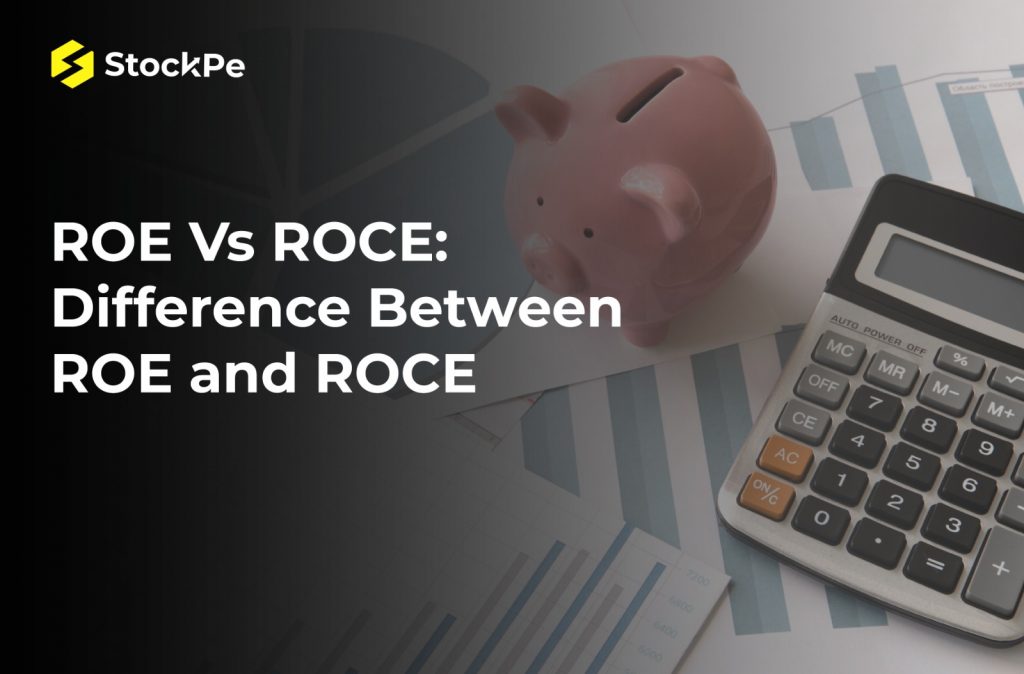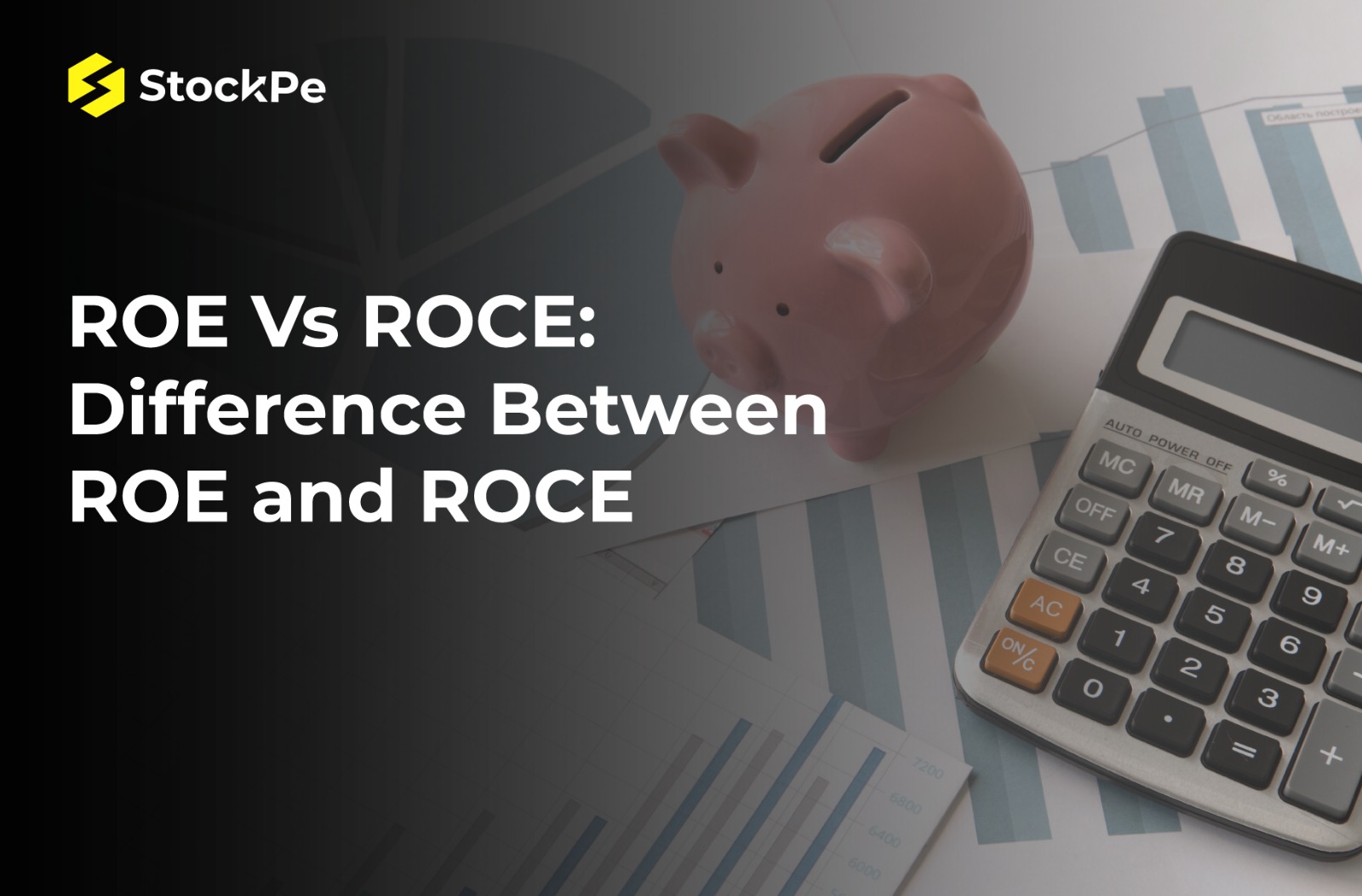Return on Equity (ROE) and Return on Capital Employed (ROCE) are two fundamental financial statistics that investors and analysts use to assess a company’s profitability and financial health. These ratios provide useful information about how successfully a firm operates its resources to generate profits and value for its owners. In this post, we’ll look at how ROE and ROCE are calculated, what they say about a company’s performance, and how they might be used in investment analysis. We will also look at the fundamental distinctions between these two ratios and identify scenarios where one is more important than the other. At the finish of this paper, you will have a better understanding of ROE and ROCE and will be able to analyse and evaluate the financial health of companies in your investment portfolio.
ROE vs ROCE: Difference between ROE and ROCE.

What is ROE?
ROE is an abbreviation meaning “Return on Equity.” It is a financial ratio that calculates how much profit a company makes for every dollar of shareholder equity. Investors use ROE to assess a company’s financial performance and capacity to create profits from shareholder investments.
The formula for determining ROE is as follows:
ROE equals net income divided by shareholder equity.
Net income is the profit produced by the firm over a given time period, whereas shareholder equity is the value of the company’s assets less liabilities as recorded on the balance sheet.
Net Income is the entire income of a firm minus its expenses and taxes for a certain time period (usually a year).
Shareholders’ equity is the amount of money invested in the company by shareholders, plus any earnings reinvested in the business. It can be calculated as follows:
Total Assets – Total Liabilities = Shareholders’ Equity
ROE is typically stated as a percentage and gives information about how effectively a firm uses the capital that its shareholders have invested in it. Greater ROE shows that the company is making more money per dollar of shareholder equity, which is generally regarded as a positive indication.
What is ROCE?
ROCE is an abbreviation for Return on Capital Employed. It is a financial measurement that assesses how well a company utilises its capital to generate profits. ROCE is computed by dividing a company’s earnings before interest and taxes (EBIT) by its capital employed (equity and debt).
ROCE is calculated as follows:
EBIT / ROCE (Total Assets – Current Liabilities)
Operational profit before interest and taxes (EBIT) is a company’s operating profit before interest and taxes are deducted.
The total amount of capital used by the company to earn profits, including both equity and debt, is referred to as capital employed.
ROCE is a percentage that indicates how much profit a company has made from its capital employed. A greater ROCE suggests that a corporation is using its capital more efficiently to produce profits.
ROCE is presented as a percentage and represents the return on total invested capital earned by a company. A greater ROCE suggests that a corporation is making better use of its capital to create profits.
ROE and ROCE are financial measures that are often used to assess a company’s profitability and efficiency.
- ROE, or return on equity, is the amount of net income generated by a corporation per dollar of shareholder equity. Divide net income by shareholders’ equity to get it. ROE is a metric that measures how successfully a firm generates profits for its shareholders. ROCE, or return on capital employed, is the amount of operating income generated by a corporation per dollar of capital invested. It is determined by dividing operational revenue by capital utilised (the total of shareholders’ equity and debt). ROCE measures how effectively a company uses its capital to produce profits.
- ROE is commonly used to assess how well a firm uses shareholder funds to make profits, whereas ROCE assesses how well a company uses all of its available capital to generate profits.
- ROE is a ratio that gauges a company’s return on its shareholders’ equity. It is computed by dividing a company’s net income by its average shareholder’s equity. ROE measures how much profit a company earns for every dollar invested in equity. ROCE, on the other hand, is a ratio that assesses a company’s return on all capital invested in its business, including both stock and debt. It is determined by dividing earnings before interest and taxes (EBIT) by total capital employed. ROCE measures how well a company uses its total capital to create profits.
- ROE is determined by dividing net income by average shareholder equity. It calculates a company’s profit from the money invested by its shareholders. A greater ROE suggests that a corporation is profiting its shareholders more.ROCE is computed by dividing earnings before interest and taxes (EBIT) by total capital utilised. It assesses a company’s profitability in relation to all capital invested in it, including both equity and debt. A greater ROCE suggests that a corporation is profitable per unit of capital utilised.
ROE and ROCE are both significant indicators for investors and analysts to use when assessing a company’s financial health and profitability. They do, however, have distinct ramifications for various companies and sectors. To gain a better picture of a company’s performance, compare these indicators to industry benchmarks and other financial statistics.
In essence, while both ratios are used to assess a company’s profitability, ROE focuses primarily on shareholder equity, whereas ROCE takes into account all types of capital utilised in the business.
Return on Equity (ROE) and Return on Capital Employed (ROCE) are two financial indicators used to assess a company’s profitability. Although they are both used to assess a company’s profitability, they focus on distinct parts of the firm, and each has its own set of advantages and disadvantages.
ROE is calculated by dividing a company’s net income by its shareholders’ equity. This ratio demonstrates how effectively a corporation generates profits from the funds contributed by its owners. A greater ROE implies that the company is effectively utilising its shareholders’ equity to produce profits. ROE is a popular metric for assessing the performance of enterprises in industries with significant entry barriers, where the majority of the company’s assets are funded.
ROCE is more comprehensive in that it considers the entire capital structure of a company, including debt financing, while ROE only considers equity financing. However, ROE is more focused on equity investors and their returns.
ROE calculates the percentage return on shareholders’ equity to determine a company’s profitability. The greater the ROE, the more profitable the company is in terms of providing returns to its owners.It disregards the company’s capital structure and the debt utilised to fund the company’s activities. Also, if a corporation has a high debt-to-equity ratio, ROE might be misleading.
ROCE, on the other hand, assesses a company’s efficiency in generating profits from its capital. It considers both stock and debt and computes the percentage return on total capital utilised in the business. ROCE offers a more comprehensive view of a company’s profitability and financial health.
ROCE, on the other hand, is commonly used to assess the effectiveness of a company’s use of all resources, including debt and equity. It is a valuable statistic for larger organisations that rely on a combination of equity and debt funding. A high ROCE shows that the company is making a solid return on all of its capital, including debt and equity, which can be a favourable sign for investors.
Therefore, whether ROE or ROCE is “better” depends on the context and objectives of the assessment. Both measures can provide useful insights into a company’s financial success, and they should be considered alongside other financial ratios and qualitative indicators.





